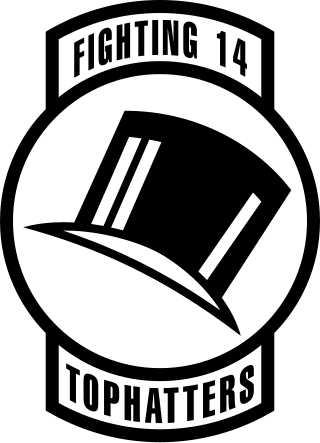
The Strike Fighter Squadron 14 (VFA-14) "Tophatters" are a United States Navy fighter attack squadron based at Naval Air Station Lemoore. They fly the F/A-18E Super Hornet, and are the Navy's oldest active squadron, having formed in 1919. Their callsign is Camelot, and their tail code is NG.

Strike Fighter Squadron 25 (VFA-25) is an aviation unit of the United States Navy based at Naval Air Station Lemoore, California. The squadron flies the Boeing F/A-18E Super Hornet and is currently assigned to Carrier Air Wing 11. Its callsign is Fist.

Strike Fighter Squadron 41 (VFA-41) also known as the "Black Aces", is a United States Navy strike fighter squadron based at Naval Air Station Lemoore, California, flying the F/A-18F Super Hornet. They are attached to Carrier Air Wing 9 (CVW-9). Their radio callsign is "Fast Eagle" and their tailcode is NG.
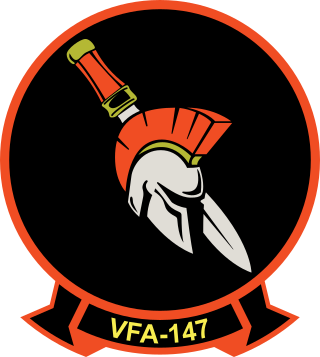
Strike Fighter Squadron 147 (VFA-147), also known as the "Argonauts," is a United States Navy strike fighter squadron based at Naval Air Station Lemoore, California (USA). VFA-147 was established on 1 February 1967 and flies the F-35C Lightning II, becoming the first non-training F-35 squadron in the U.S. Navy.
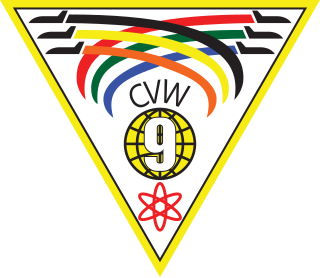
Carrier Air Wing Nine (CVW-9) is a United States Navy aircraft carrier air wing based at Naval Air Station Lemoore. The Air Wing is currently assigned to the aircraft carrier USS Abraham Lincoln (CVN-72). The Tail Code of aircraft assigned to CVW-9 is NG.

Strike Fighter Squadron 2 (VFA-2) also known as the "Bounty Hunters" is a United States Navy F/A-18F Super Hornet strike fighter squadron based at Naval Air Station Lemoore, California. Their tail code is NE and their callsign is "Bullet". They are attached to Carrier Air Wing 2 (CVW-2), a composite unit made up of a wide array of aircraft performing a variety of combat and support missions that deploy aboard the Carl Vinson.
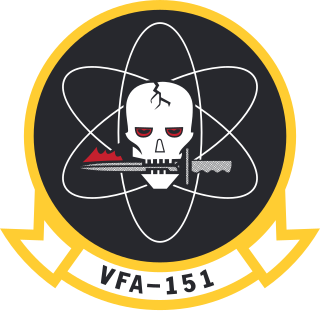
Strike Fighter Squadron One Five One (VFA-151) nicknamed the Vigilantes are a United States Navy F/A-18E Super Hornet fighter squadron stationed at Naval Air Station Lemoore, California. The squadron is a part of Carrier Air Wing 9 (CVW-9). As part of CVW-9, the squadron's tail code is NG and its radio callsign is "Ugly".

Strike Fighter Squadron 146 (VFA-146) also known as the "Blue Diamonds" is a United States Navy operational fleet strike fighter squadron based at Naval Air Station Lemoore California. They fly the F/A-18E Super Hornet and are attached to Carrier Air Wing 17, deployed aboard USS Nimitz. Their tailcode is NA and their radio callsign is Diamond.

Strike Fighter Squadron 154 (VFA-154), also known as the "Black Knights", is a United States Navy strike fighter squadron stationed at Naval Air Station Lemoore. The Black Knights are an operational fleet squadron flying the F/A-18F Super Hornet. They are currently attached to Carrier Air Wing Eleven and deployed aboard the aircraft carrier USS Theodore Roosevelt. Their tailcode is NH and their callsign is "Knight".

Strike Fighter Squadron 97 (VFA-97) is a naval aviation squadron of the United States Navy. It is equipped with the F-35C Lightning II and is stationed at Naval Air Station Lemoore. The squadron is nicknamed "Warhawks" and it is currently assigned to Carrier Air Wing Two, tail code "NE". The squadron was originally established as Attack Squadron 97 (VA-97) on 1 June 1967 and redesignated VFA-97 on 24 January 1991.
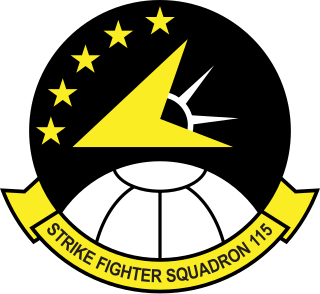
Strike Fighter Squadron 115 (VFA-115) is known as the "Eagles", callsign "Talon", a United States Navy F/A-18E Super Hornet strike fighter squadron stationed at Marine Corps Air Station Iwakuni. Their tail code is NF. It was established as Torpedo Squadron VT-11 on 10 October 1942, redesignated VA-12A on 15 November 1946, VA-115 on 15 July 1948, then finally VFA-115.

Strike Fighter Squadron 137 (VFA-137), also known as the "Kestrels", are a United States Navy F/A-18E Super Hornet strike fighter squadron stationed at Naval Air Station Lemoore, California. Their radio callsign is "Falcon".
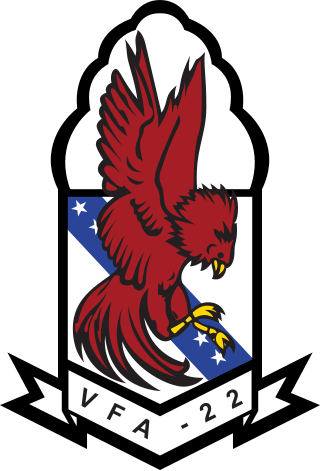
VFA-22, Strike Fighter Squadron 22, also known as the "Fighting Redcocks", are a United States Navy F/A-18F Super Hornet fighter squadron stationed at Naval Air Station Lemoore, California. Their tail code is NA and their radio callsign alternates between "Beef" and "Beef Eater".

Strike Fighter Squadron 195 (VFA-195), also known as the "Dambusters", is a United States Navy F/A-18E Super Hornet fighter squadron stationed at Marine Corps Air Station Iwakuni, Japan. They are a part of Carrier Air Wing Five (CVW-5) and their tail code is NF. Their radio callsign is "Chippy".

Strike Fighter Squadron 113 (VFA-113), also known as the "Stingers," is a United States Navy strike fighter squadron based at Naval Air Station Lemoore, California. They are an operational fleet F/A-18E Super Hornet squadron attached to Carrier Air Wing 2 (CVW-2) and based at NAS Lemoore, California. Their tailcode is NE and their radio callsign is Sting.

Strike Fighter Squadron 34 (VFA-34), also known as the "Blue Blasters", is a United States Navy F/A-18E Super Hornet strike fighter squadron stationed at Naval Air Station Oceana. They are a part of Carrier Air Wing 11 and are attached to the aircraft carrier USS Theodore Roosevelt. Their tail code is NH and their radio call sign is "Joker".
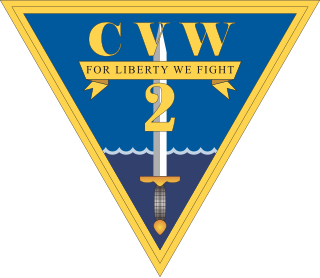
Carrier Air Wing Two (CVW-2) is a United States Navy aircraft carrier air wing based at Naval Air Station Lemoore. The air wing is attached to the aircraft carrier USS Carl Vinson (CVN-70).
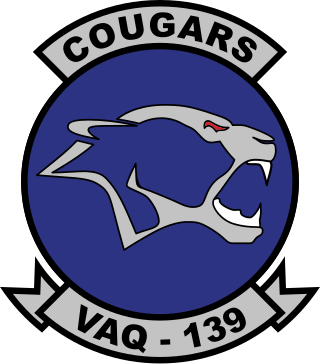
Electromagnetic Attack Squadron 139 (VAQ-139), also known as the "Cougars", is an EA-18G Growler squadron of the United States Navy. They specialize in electromagnetic attack and are currently stationed at Naval Air Station Whidbey Island, Washington. Part of Carrier Air Wing Seventeen, the Cougars deploy aboard the aircraft carrier USS Nimitz
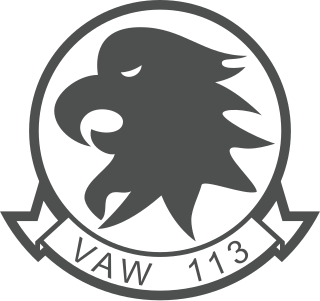
Airborne Command & Control Squadron 113 (VAW-113), known as "Black Eagles", was established on 20 April 1967 flying the E-2A Hawkeye.

Carrier Strike Group Seven 2004–2006 operations included one deployments to the U.S. Fifth Fleet, and its embarked carrier air wing flew approximately 2940 air sorties in support of ground forces in Iraq and Afghanistan while CARSTRKGRU-7 surface warships supported theater security and maritime interdiction operation within that fleet's area of responsibility. It also participated in Valiant Shield 2006, a major joint military exercise of the U.S. Pacific Command. Finally, Carrier Strike Group Seven provided humanitarian assistance after the 2004 Indian Ocean earthquake. Prior to being re-designated as Carrier Strike Group Seven on 1 October 2004, Carrier Group Seven (CarGru-7) and its John C. Stennis Carrier Battle Group participated in three different exercises during Summer Pulse 2004, a multi-carrier surge deployment to test the U.S. Navy's then-new Fleet Response Plan.
































